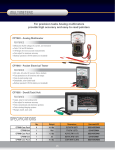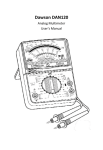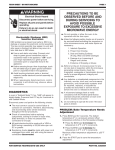Transcript
ANALOG MULTIMETER CP7849 11.Function range switch: A 16 position switch located at the center of the meter. This switch is used to select the function and range to be measured. 12.DC milliamps: This function is used for measuring the DC Current (Direct Current). 13.Mechanical adjuster: A screw located directly below the center of the meter scale. The mechanical adjuster is used to set the meter pointer to the Zero mark at the left side of the black scale. Power supply: One 1.5V, size “AA” cell battery for Ohmmeter. Size & Weight (with protective boot): 88mm x 155 mm x 49 mm, 288 g. 7. Do not check resistance when voltage or current is present in the circuit. 8. Discharge a capacitor before measuring it. 9. When the multimeter is not in use, keep the function range switch in the “OFF” position. This provides a direct short across the meter movement, stabilizing the needle for minimum needle bounce when transporting the multimeter. 10.If excessive voltage or current is accidentally applied on a certain range, disconnect the leads from the circuit as quickly as possible. Check the multimeter operation on that range by applying an appropriate input. If the multimeter does not operate properly, check the fuse; if it is blown, replace it. (See Fuse Replacement) most accurate reading on an ohmmeter ranges between the middle of the scale and Zero Ohms. BATTERY CHECK 1. Read all SAFETY PRECAUTIONS. 2. Set the selector switch to the appropriate BAT range. 3. Touch and hold the RED test lead to the (+) positive battery terminal and the BLACK test lead to the (-) negative battery terminal. 4. Read the BAT scale to determine the battery condition. If the reading is in the red “BAD” zone, the battery should be replaced. If the reading is in the green “GOOD” zone, the battery has considerable life left. If the reading is in the “?” zone, the battery should be replaced soon because the remaining power is very low. SAFETY PRECAUTIONS OPERATING INSTRUCTIONS 1. Always visually inspect the multimeter, test leads, and circuit under test for damage prior to every use. 2. Turn off power and discharge any capacitors and inductors prior to connecting or removing test leads from an electrical circuit or electronic equipment. 3. Always keep yourself isolated from an electrical circuit when making measurements. When possible use one hand to make measurements. 4. Never allow yourself to be grounded when making electrical measurements. Stand on a rubber mat, wear dry clothing, use insulated test probes, and be careful of all exposed metal when making electrical measurements. 5. Never hold multimeter when making electrical measurements. Place the multimeter on a clean insulated surface before making any electrical measurements. OPERATING PROCEDURES DC VOLTAGE MEASUREMENT 1. Read all SAFETY PRECAUTIONS. 2. Set the function range switch to the appropriate DC voltage range. If the voltage is unknown, use the highest range. 3. If the polarity of the circuit to be tested is known, connect the BLACK probe to the (-) negative voltage side of the circuit, and the RED probe to the (+) positive voltage side. 4. If the polarity of the circuit to be tested is not known, connect the probes to opposite sides of the circuit and watch the meter pointer. If the meter pointer deflects to the left, reverse the probes. The RED probe will now be connected to the (+) positive voltage side. 5. Use the black scale for reading DC voltage measurements. GENERAL DESCRIPTION The CP7849 Analog Multimeter is a rugged, accurate, easy-to-operate, compact instrument. The stable linear meter movement allows it to make accurate measurements of AC and DC voltages, DC currents in the milliamp range, resistance, and decibels. The multimeter uses the most modern components and circuit techniques designed in a high-impact case. If the tester is kept clean and is not subjected to extreme shock or continuous vibration, it will provide many years of trouble-free service. SPECIFICATIONS ELECTRICAL Range: DC voltage: AC voltage: DC current: Resistance: Decibel: Accuracies: BAT test: 19 measuring ranges 0-2.5-10-50-250-500 volts 0-10-50-500 volts 0-0.5-10-250 mA RX10 Ohm, RX1kOhm -10 dB to 56 dB at AC volt ranges DC V/mA, AC V, Resistance 5% of Full Scale 1.5V and 9V batteries 10% of Full Scale MULTIMETER BASIC FUNCTIONS 1. Protective boot 2. Meter 3. OHMS: This function is used for measuring the resistance of a component. 4. Zero Adjuster: A thumbwheel adjustment located on the left side of the multimeter. The zero adjuster is used to zero the meter pointer when making resistance measurements. 5. AC VOLTS: This function is used for measuring AC (Alternating Current) voltages. 6. BAT: This function is used for testing 1.5V and 9V batteries under load. 7. Protective Caps: Keep the caps on when the multimeter is not in use. 8. Test leads 9. OFF: When the multimeter is not in use, keep the function range switch in the OFF position. 10.DC VOLTS: This function is used to measure DC (Direct Current) voltages. ACTRON CAUTION ! When making voltage or current measurements, form the habit of turning off all power to the circuit under test, and discharge any capacitors and inductors. Connect the test leads at the desired points in the circuit and then turn on the power while taking readings. Turn off the power and discharge any capacitors and inductors, before disconnecting the test leads from the circuit. PRELIMINARY ADJUSTMENTS Adjust the meter pointer to the Zero mark at the left side of the black scale before making any measurements. First, check to see if the meter pointer indicates Zero at the extreme left end of the black scale. If it is off-Zero, use a small screwdriver to turn the mechanical adjuster screw on the meter movement slowly CW (clockwise) or CCW (counterclockwise) until the meter pointer is exactly over the Zero mark. INTERNAL BATTERY CHECK Important: A 1.5V “AA” cell battery must be installed before using the CP7849. (See Battery Replacement) In order to check the battery condition, set the function range switch to the RX10 position and touch the ends of the two test leads together. Rotate the Zero Adjuster thumbwheel located on the left side of the multimeter until the pointer indicates Zero on the green OHMS scale. If the pointer cannot be brought to the Zero mark, replace the 1.5 volt size “AA” cell battery. (See Battery Replacement) 1. No periodic maintenance is required other than replacement of the battery, fuse, and visual inspection of the multimeter. 2. Keep the instrument clean and dry. Do not use solvent for cleaning; use a damp cloth. 3. The only field replaceable parts are the 1.5V “AA” cell battery and the Fast-Acting 5mm X 20mm, 500mA, 250V fuse. BATTERY REPLACEMENT 1. Read all SAFETY PRECAUTIONS. 2. Set the function range switch to the appropriate DC mA range. If the current is unknown, use the highest range. 3. Using the test leads, connect the multimeter in series with the circuit under test. If the meter pointer deflects to the left, reverse the test probes. 4. Use the black scale for reading DC mA measurements. Important: A 1.5V “AA” cell battery must be installed before using the CP7849. 1. Rotate the function range switch to the OFF position. 2. Remove protective boot. 3. Remove screws from rear of multimeter and lift off the back cover. 4. Install a new 1.5V “AA” cell battery. Observe the polarity marks. 5. Carefully replace the back cover and tighten the screws. Be careful not to over tighten the screws, because the threads in the case may become stripped. 6. Replace protective boot. AC VOLTAGE MEASUREMENT FUSE REPLACEMENT 1. Read all SAFETY PRECAUTIONS. 2. Set the function range switch to the appropriate AC voltage range. If the voltage is unknown, use the highest range. 3. Connect the RED and BLACK test probes to opposite sides of the AC voltage source. (Polarity of test probes is not important when measuring AC voltage.) 4. Use the red scale for 10V AC voltage measurements. Use the black scale for 50V and 500V AC voltage measurements. Important: If the multimeter won’t work at all, check the fuse located inside the multimeter. If the fuse is blown, all functions stop working. 1. Rotate the function range switch to the OFF position. 2. Remove protective boot. 3. Remove screws from rear of multimeter, and lift off the back cover. 4. Replace blown fuse with a new Fast-Acting 5mm X 20mm, 500mA, 250V fuse. 5. Carefully replace the back cover and tighten the screws. Be careful not to over tighten the screws, because the threads in the case may become stripped. 6. Replace protective boot. DC CURRENT MEASUREMENT OPERATING INSTRUCTIONS MAINTENANCE GENERAL DECIBEL 1. Read all SAFETY PRECAUTIONS. 2. Set the function range switch to the appropriate AC voltage range for the dB range you wish to measure. 3. For a function range switch setting of 10 AC V, read the dB directly from the bottom red scale. For other AC V settings of the function range switch, add the appropriate number of dB to the dB scale reading as noted on the chart at the lower right corner of the meter face. RESISTANCE MEASUREMENT OPERATING SUGGESTIONS 1. Set the range switch to the proper position before taking any measurement. 2. Never apply more voltage or current than the amount noted in each position. 3. When the voltage or current to be measured is not known, always start with the highest range in each case. 4. If the meter pointer is in the lower half of the scale and falls within the range of a lower function range switch position, then rotate the function range switch to the lower range for greatest accuracy. 5. If none of the multimeter functions work at all, check the fuse located inside the multimeter on the printed circuit board. If the fuse is blown, replace it. (See Fuse Replacement) 6. Avoid placing the multimeter in a place where severe vibration is encountered. Do not store it in excessively hot or damp places! 1. Read all SAFETY PRECAUTIONS. 2. Turn off all power in circuit before making resistance measurements. 3. Set the function range switch to the appropriate OHM range. If the resistance is unknown, use the highest range. 4. Touch the ends of the two test leads together. Rotate the Zero Adjuster thumbwheel located on the left side of the multimeter until the pointer indicates Zero on the green OHMS scale. If the pointer cannot be brought to the Zero mark, replace the 1.5 volt size “AA” cell battery. (See Battery Replacement) 5. Connect the test probes across the resistance to be measured. 6. Take a reading on the green OHMS scale and multiply it by the multiplication factor indicated by the function range switch. Multiply reading by 1K (1000 ) for the RX1K position and, by 10 for the RX10 switch position. The units for the RX10 position are Ohms “ ”. 7. If there is little or no meter pointer movement from the left side of the green OHMS scale, rotate the function range switch to a higher range in an effort to get a greater deflection of the meter pointer. The HAND TOOLS










